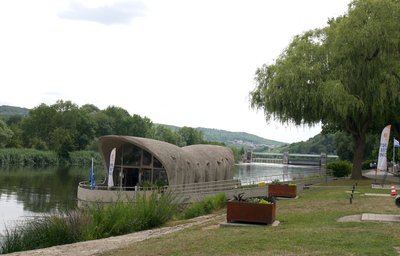Grevenmacher to Trier
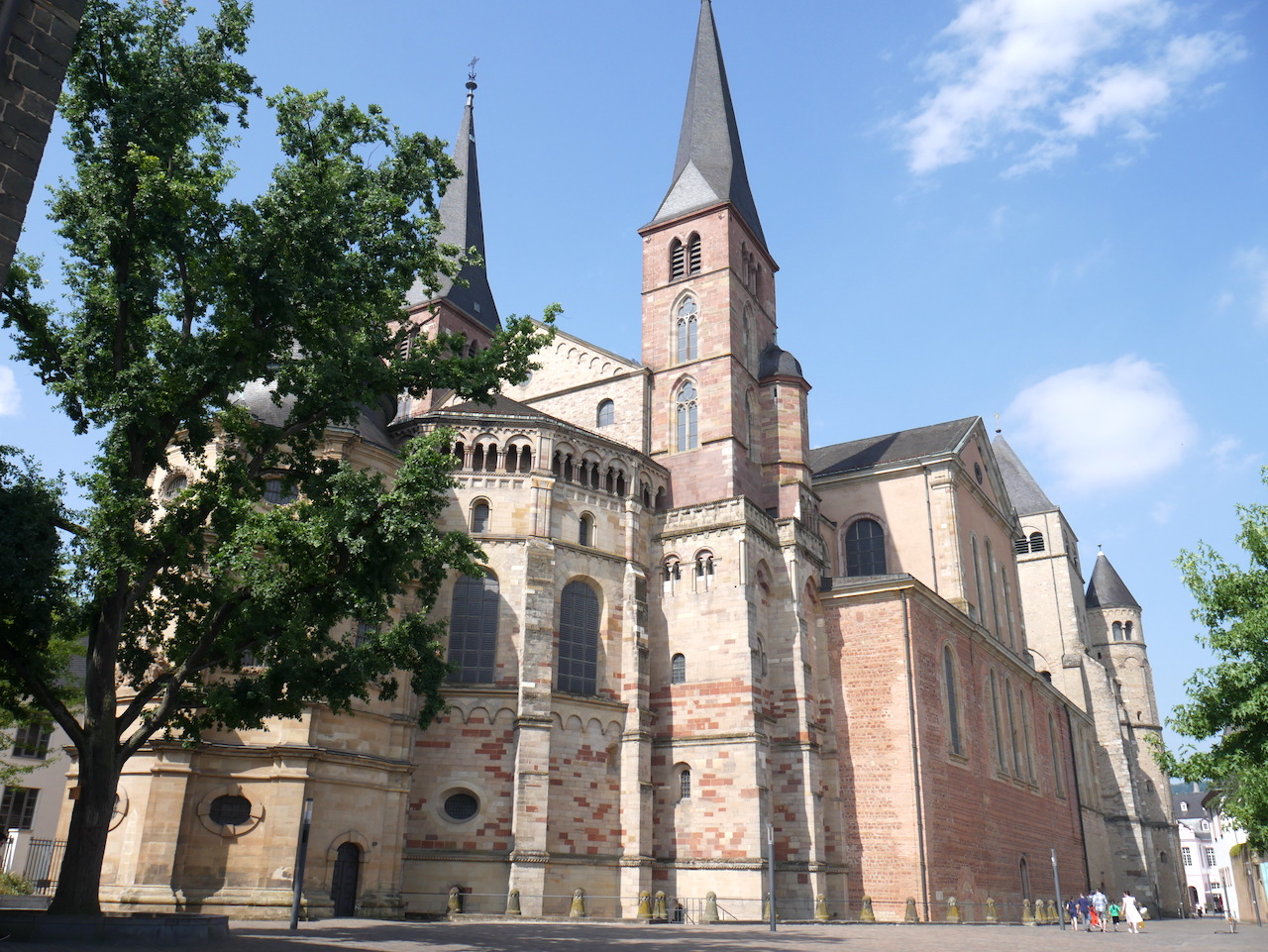
Grevenmacher
2. Grevenmacher to Trier
Difficult
7h
45,1km
+595m
-599m
Step
Embed this item to access it offline
PAfter a walk in the vineyard you will leave Luxembourg to arrive in Germany. Following the left bank of the Moselle river you will reach the suburbs of Trier and then the rich heritage of the city with the Roman Baths (Barbarathermen) passing by the Roman Basilica, founded by Emperor Constantine in the 4th century, the Liebfrauenkirche (Church of Our Lady) and then St. Peter's Cathedral. Trier's rich heritage deserves a day dedicated to it.
11 points of interest

Église Saint-Laurent à Grevenmacher - Les Amis de saint Colomban TouristSt. Lawrence Church in Grevenmacher
Since 1782, the belfry has served as the bell tower of the decanal church of Saint-Laurent. The old watchtower dates from the 12th century and is located exactly in the middle of the old fortified enclosure. The nave was built by the Cistercian abbey of Clairefontaine (in 1782).
La « Dent Creuse » ou tour d’angle de l’ancien rempart à Grevenmacher - Les Amis de saint Colomban HistoricalFormer ramparts of Grevenmacher
As early as Roman times, the town was an important trading centre on the road to Trier. The city had to endure several assaults and invasions.
Remains of the fortress dating from 1252 have been restored as well as parts of the city walls, thus preserving the historical memory of the city.
One of the last vestiges of the fortified town is a corner tower of the rampart called "La Dent Creuse" (The Hollow Tooth), the current shape of the tower is reminiscent of a hollow tooth. The ditch was fed by a stream. Another tower is still visible among the houses nearby.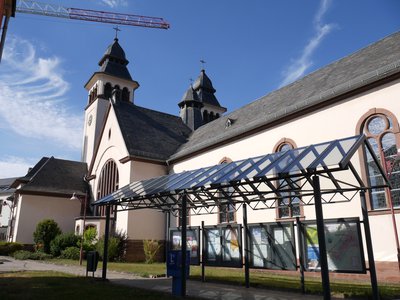
Église Saint-Martin à Wasserbilling - Les Amis de saint Colomban TouristSt. Martin's Church in Wasserbillig
From the 12th century until the end of the 19th century the church in Wasserbillig was the parish church of Wasserbillig and Oberbillig.
A first church had been built at the confluence of the Moselle and Sauer rivers, but regular flooding encouraged St. Maximin's Abbey in Trier, owner of the parish, to rebuild a new church further back from the rivers. This church was desecrated and destroyed in 1810.
In 1792 work on the new church began but was stopped in 1795 after the annexation of Luxembourg by France and the closure of the monasteries. The town of Wasserbillig took over the work to finish the construction of this baroque church which was inaugurated in 1808. The high altar and the two side altars were provided by the monastery of Bernkastel. In 1933, the relocation of the cemetery to the outskirts of the town made it possible to build the two towers and the sacristy.
The church was closed.
Chapelle Saint-Michel à Oberkirch vue depuis la via Columbani - Les Amis de saint Colomban TouristSt. Michael Chapel in Oberkirch
St. Michael's Chapel is 100 metres from the Via Columbani in the Oberkirch district of Trier. It was built in 1768 by Carl Franz Ludwig Freiherr, Bishop of Trier.
The dominant part of the furnishings is a wooden altar by Johannes Koch from 1785, on which both the battle of St. Michael with the seducer and St. Helena are depicted. Statues of St. Leonard and St. Walburga stand on the confessionals.
The chapel is closed.
Walburga is an 8th century nun who evangelized the Germans under the authority of St. Boniface of Mainz. Saint Boniface, apostle of Friesland and Bavaria, is of Anglo-Saxon origin. In the 8th century religious men and women from Wessex accompanied Boniface to the continent to convert the pagans still present in present-day Germany.
Les sarcophages au bord de la via Columbani ont été découverts dans la zone humide. - Les Amis de saint Colomban PanoramicThe nature reserve of Monaise
Three enormous construction measures will mark the recent history of the Moselle: the extension of the Moselle to a large barge route until the 1960s, the deepening of the channel from 1992 to 1999 and the current construction of the second locks of the ten German dams. More than ever, however, it is necessary to maintain the delicate balance between the needs of a society shaped by the economy and the needs of nature.
New habitats for plants and animals typical of watercourses and new parallel plants are emerging. As compensation for the interventions during the construction of the upper project in Wintrich, "Auf des Obersten Ray" created a flat branch of the Moselle over a length of 200 metres. The construction of the second lock on the Moselle also requires the creation of ecologically valuable areas. In 2007, nature was given a typical floodplain flood zone at the Zeltinger dam on the "Graacher Werth". At "Monaise" near Trier, an area of 12 hectares of arable land was transformed into a body of water comparable to an arc-shaped lake. Since 2016, the design of this area has been left to nature alone with lakes and floodplains like the one you are walking on. During the development work, archaeological discoveries have unearthed tools from the Iron Age, Roman times and subsequent periods. The two sarcophagi bear witness to these discoveries.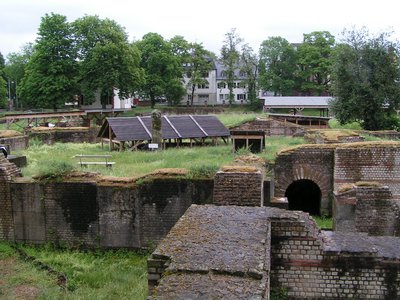
Vue de site archéologique Barbaratherm - Wikipédia-image : Stefan Kühn HistoricalBarbarathermen in Trier
The Barbara Thermal Baths in Trier are the largest Roman thermal baths north of the Alps. Like the other Roman buildings in Trier, it was included in the UNESCO World Heritage List in 1986.
The Barbara Thermal Baths were built in the 2nd century B.C.. At the time of their construction, the baths were probably 172 × 240 m in size. Today it is no longer possible to recognize the original footprint of the building, as it was used for centuries as a stone quarry for the houses and churches of the town before it was finally mined with explosives.
A museum has been built nearby to present the history of the site.
More info at: Wikipedia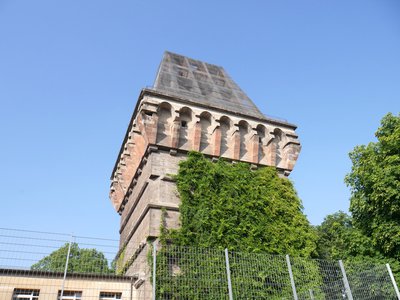
Hochbunker à Trèves - Les Amis de saint Colomban HistoricalHochbunker Augustinerhof
The high bunker of the city of Trier on the Augustinerhof, right next to the town hall, is an unfinished bunker above the surface of the earth. It is 38 m high and is a listed building. Immediately after the construction of the high bunker tower there is a flat bunker with a single floor visible above ground, which was built at the same time as the high bunker and was originally connected to it. The whole complex has two basements. Corresponding facilities for energy supply and communication as well as a drinking water well have been provided.
It was designed to protect city officials and civilians from air strikes. The high bunker was used, but was never fully completed.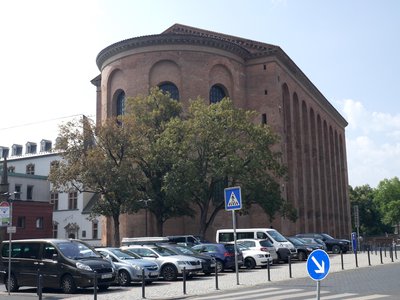
Basilique de Constantin à Trèves - Les Amis de saint Colomban HistoricalAula Palatina in Trier
The Aula Palatina in Trier, originally a Roman aula (or covered gallery), houses a reconstruction of the largest surviving hall from antiquity. It was built between the 3rd and 4th centuries and served as the throne room of Emperor Constantine. The interior was clad in marble facings, with niches containing effigies. The floor and walls were heated.
The present appearance of the basilica does not reflect the original architecture, because at the time the bricks were covered with plaster. Some traces of this original plaster and some ancient features have been preserved at the level of the bays.
The heating of the room was provided by a hypocaust system consisting of a double floor fed by five boilers, with heat ducts evacuating the hot air through the thickness of the walls.
But this building was destroyed in the 5th century by the Franks, who built a housing estate in the roofless ruin. Later the walls were converted into a castle. Later the complex served as a princely residence for the Archbishop of Trier. The apse was converted into a tower house, flanked by turrets at the junction with the facade, and the walls cut with battlements. This aspect prevailed until around 1600. In 1856 Protestants occupied the building, which is still the Protestant Church of the Saviour today.
At the beginning of the 17th century, Archbishop Lothario of Metternich had his princely palace built next to the basilica.
More information :Wikipedia
Thermes impériaux de Constance Chlore, vue de l’extérieur. - Les Amis de saint Colomban HistoricalThe Imperial Baths of Constance Chlore
The first works began in the 3rd century, intended for the army the building of unknown origin. Work was resumed at the beginning of the 4th century, during the reign of Constance Chlorine, who offered these baths to the population of the city of Trier.
The remains are impressive and still provide an impressive view of the thermal baths. For a long time considered an imperial palace, today it is known as the Imperial Baths (Kaiserthermen). Because of its ground plan, the thermal baths are considered to be one of the largest in Gaul. Visit the underground galleries with their fireplaces for heating.
In the following centuries, the Kaiserthermen were converted and used successively as a castle, surrounding wall and monastery. In the 19th century, excavation work began on the remains of the monument, then in 1984, several windows in the apse were rebuilt. The Kaiserthermen are still part of Trier's city centre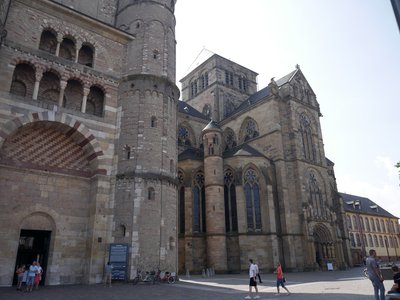
Façade de la cathédrale et de la basilique Notre-Dame de Trèves - Les Amis de saint Colomban TouristChurch of Our Lady of Trier
The Church of Our Lady of Trier (in German; Liebfrauenkirche which adjoins Trier's St. Peter's Cathedral) is a church built in the 13th century. After the old church complex from the time of Constantine the Great had to be demolished after almost a millennium due to the collapses, the Archbishop of Trier, Theodoric II of Wied, began to build the Church of Our Lady. The foundations of the old religious building were partially reused. The precise date of the beginning of the work cannot be identified: an inscription inside the church, on a pillar, says: "The construction of this church began in 1227 and was completed in 1243", but it is now believed that construction did not begin until 1230.
The Church of Our Lady was used by the members of the Trier Cathedral Chapter to celebrate their daily mass, and they also used it as a site for their burials. However, over the centuries it was filled with graves and during the French Revolution most of them were moved.
From 1859 to the 1890s, with some interruptions, a major restoration took place. With the Second World War, the church suffered serious damage and was rebuilt between 1946 and 1951.
It is one of the first Gothic style churches in Germany in the shape of a Greek cross. The interior contains magnificent frescoes from the 15th century.
More info at: Wikipedia
Façade ouest de la cathédrale Saint-Pierre à Trier - Les Amis de saint Colomban TouristCathedral of St. Peter in Trier
St. Peter's Cathedral in Trier was built between 1235 and 1270 and is the oldest cathedral in Germany.
According to medieval traditions from Trier dating back to the 9th century, but not certain, Helena, mother of Emperor Constantine (the future St. Helena) is said to have donated her house in the Roman city of Augusta Treverorum to Agritius, the Bishop of Trier.
The buildings were left in ruins by the Franks in the first half of the 5th century. Bishop Nicatius (526-561) had the square building and part of the north church rebuilt by Italian architects.
The Normans plundered and seriously damaged the building in 882. Under Bishop Egbert (977-993), the cathedral was restored. The Romanesque choir dating from 1196 and its crypt are attached to the east wall of the square building. The cathedral has a set of vaults.
At the end of the Thirty Years' War between 1664 and 1668, Archbishop Gaspard von der Leyen restored the interior of the west choir in Baroque style.
Between 1687 and 1699 Jean von Orsbeck had the front of the chapel of the Holy Tunic, a precious relic of the cathedral, built. Between 1702 and 1708, a sacred chamber was added upstream of the choir to house the relic.
The Holy Tunic
Legend has it that Helena, mother of the Emperor Constantine, bequeathed (or according to another tradition donated) the Holy Tunic (a garment Jesus would have worn) to the Bishop of Trier Agritius. The local tradition of the existence of this tunic in Trier is late: it is first mentioned around 1060 by the biographer of St. Agritius. A century later, on May 1, 1196, it was transferred from the Cathedral's St. Nicholas Chapel to the new high altar of the oriented choir. The cathedral has two apses to the east and west.
More info: Wikipedia
Description
Departure from the Saint Laurent church on the right, cross the market square, take the Passage on the right rue Sainte-Catherine, on the left route de Trèves DR108 then N 1, after roundabout N 10, take the pedestrian way which goes along the national road
- Left on the pedestrian way at the next crossroads, then immediately right, cross the N 1D and enter the vineyards by the path on your right, second path on the left up into the vineyards.
- Turn right and go straight down to the N10 -N1, take the pedestrian way along the Route du Vin, straight on at the roundabout, third street on the left, An de Kampen, on the right along the vineyard, continue on rue de Mertert.
- Right rue du Bocksberg, right rue Nicolas Ueberecken, cross the park and the car park of the Maison Communale, left Grand-Rue, cross the river and take the towpath on the left bank of the Moselle.
- Turn left after the camping site in Trier, Luxemburger Straße, then right Luxemburger Straße, at the crossroads turn right into Mosel Römerbrücke, Karl-Marx-Straße, Brückenstraße, cross the square into Fleichstraße
- Turn right through Kornmarkt, Johann-Philipp-Straße, continue along Konstantinstraße, bypass the shopping centre on the left into An der Meerkatz, on the right into Liefrauenstraße you will arrive in front of Trier Cathedral.
- Departure : Saint-Laurent Church,15 rue de l'Église, 6720 Grevenmacher, Grand-Duché de Luxembourg
- Arrival : Cathedral St. Peter Liebfrauenstraße 12, D-54290, Trier
- Towns crossed : Grevenmacher and Rheinland-Pfalz
Altimetric profile
Transport
Report a problem or an error
If you have found an error on this page or if you have noticed any problems during your hike, please report them to us here:








